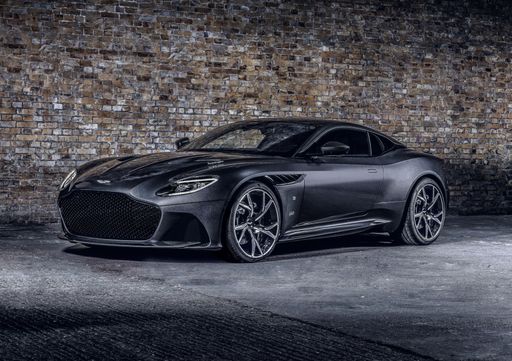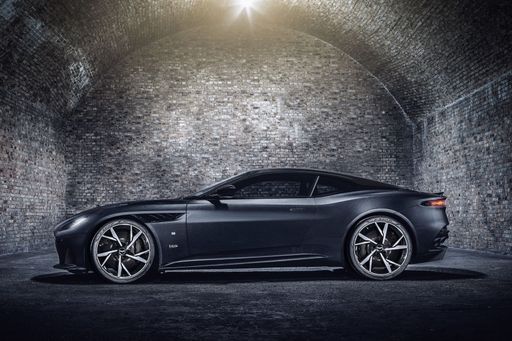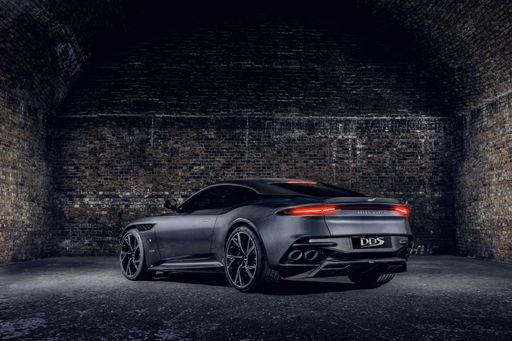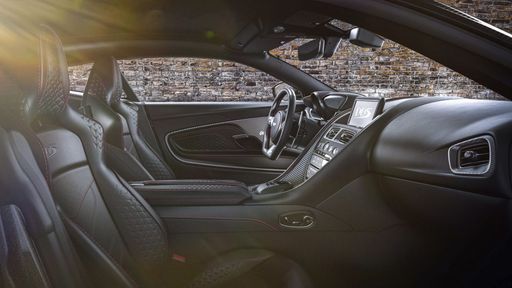Aston Martin DBS Superleggera Coupe VS Renault Trafic Bus
Aston Martin DBS Superleggera Coupe
The Aston Martin DBS Superleggera Coupe represents a sublime blend of sophisticated design and exhilarating performance, capturing the essence of grand touring luxury. Its exterior exudes an aggressive yet elegant stance, complemented by a meticulously crafted interior that envelops passengers in opulent comfort. This masterpiece of British engineering offers an unforgettable driving experience, powered by a formidable engine that delivers exceptional speed and refined handling.
more informationRenault Trafic Bus
The Renault Trafic Bus is a versatile and spacious option for those needing to transport multiple passengers comfortably. With its modern design and practical features, it is well-suited for both business and leisure purposes. Its efficient engine and smooth handling make it a reliable choice for long journeys.
more information @ media.astonmartin.com
@ media.astonmartin.com
 @ media.astonmartin.com
@ media.astonmartin.com
 @ media.astonmartin.com
@ media.astonmartin.com
 @ media.astonmartin.com
@ media.astonmartin.com
Costs and Consumption |
|
|---|---|
|
Price
about 330000
$
|
Price
about 38800 - 56000
$
|
|
Consumption L/100km
13.5
L
|
Consumption L/100km
6.8 - 7.2
L
|
|
Consumption kWh/100km
-
|
Consumption kWh/100km
-
|
|
Electric Range
-
|
Electric Range
-
|
|
Battery Capacity
-
|
Battery Capacity
-
|
|
co2
314
g/km
|
co2
178 - 190
g/km
|
|
Fuel tank capacity
75
L
|
Fuel tank capacity
80
L
|
Dimensions and Body |
|
|
Body Type
Coupe
|
Body Type
Bus
|
|
Seats
4
|
Seats
8
|
|
Doors
3
|
Doors
4
|
|
Curb weight
1845
kg
|
Curb weight
2041 - 2340
kg
|
|
Trunk capacity
270
L
|
Trunk capacity
-
|
|
Length
4715
mm
|
Length
5080 - 5480
mm
|
|
Width
1970
mm
|
Width
1956
mm
|
|
Height
1285
mm
|
Height
1973 - 1974
mm
|
|
Payload
420
kg
|
Payload
730 - 1010
kg
|
Engine and Performance |
|
|
Engine Type
Petrol
|
Engine Type
Diesel
|
|
Transmission
Automatic
|
Transmission
Manuel, Automatic
|
|
Transmission Detail
Automatic Gearbox
|
Transmission Detail
Manual Gearbox, Automat. Schaltgetriebe (Doppelkupplung)
|
|
Drive Type
Rear-Wheel Drive
|
Drive Type
Front-Wheel Drive
|
|
Power HP
770
HP
|
Power HP
110 - 170
HP
|
|
Acceleration 0-100km/h
3.4
s
|
Acceleration 0-100km/h
10.6 - 16.5
s
|
|
Max Speed
338
km/h
|
Max Speed
161 - 186
km/h
|
|
Torque
900
Nm
|
Torque
300 - 380
Nm
|
|
Number of Cylinders
12
|
Number of Cylinders
4
|
|
Power kW
566
kW
|
Power kW
81 - 125
kW
|
|
Engine capacity
5204
cm3
|
Engine capacity
1997
cm3
|
|
Top speed
338
km/h
|
Top speed
161 - 186
km/h
|
General |
|
|
Model Year
2023
|
Model Year
2023
|
|
CO2 Efficiency Class
G
|
CO2 Efficiency Class
G
|
|
Brand
Aston Martin
|
Brand
Renault
|
Aston Martin DBS Superleggera Coupe
Unleashing the Beast: The Aston Martin DBS Superleggera Coupe
The Aston Martin DBS Superleggera Coupe is a true embodiment of British engineering excellence and automotive artistry. With its seductive design and heart-pounding performance, the DBS Superleggera is not merely a car but an experience on wheels. Let's delve into the technical brilliance and innovative features that make this vehicle a masterpiece.
A Symphony of Power: The Engine
At the core of the DBS Superleggera beats a formidable 5.2-litre V12 engine. This powertrain is no ordinary component; it churns out a staggering 770 PS (566 kW) and delivers a breath-taking torque of 900 Nm, propelling this coupe from 0 to 100 km/h in just 3.4 seconds. Such remarkable performance figures are further complemented by a top speed of 338 km/h, asserting its dominance in the realm of supercars.
Sculpted for Perfection: Design and Aerodynamics
The design of the DBS Superleggera is a testament to Aston Martin's commitment to craftsmanship and innovation. Every curve and contour is meticulously sculpted, not just for aesthetic appeal but to enhance aerodynamic efficiency. The sleek silhouette is accompanied by advanced aerodynamics that provide substantial downforce, ensuring stability at high speeds while maintaining a graceful poise on the road.
Driving Dynamics: Precision and Control
The DBS Superleggera features a sophisticated rear-wheel-drive system mated to a Touchtronic automatic transmission. This setup ensures seamless power delivery, allowing drivers to harness the car's immense power with precision and ease. The finely-tuned suspension system offers an optimal balance between comfort and performance, adapting to various driving conditions and providing a dynamic and engaging experience behind the wheel.
Luxurious Cabin: A Fusion of Comfort and Technology
Stepping into the cabin of the DBS Superleggera is a luxurious escape into a world designed with the driver in mind. The interior boasts exquisite craftsmanship with the finest materials, including premium leather and carbon fibre accents. State-of-the-art technology, including an intuitive infotainment system and driver-focused interfaces, keeps you connected and in command effortlessly.
Efficiency and Practicality: The Aston Paradox
Despite its supercar performance, the DBS Superleggera manages a blend of practicality and efficiency. With a fuel consumption of 13.5 L/100km and CO2 emissions of 314 g/km, it strikes a rare balance in its class. The spacious boot offers 270 litres of storage, making it feasible for more than just spirited driving.
Conclusion: A Masterpiece of Performance and Elegance
The Aston Martin DBS Superleggera Coupe stands as a pinnacle of automotive design and engineering. It effortlessly combines extraordinary performance with luxury and elegance, making it a dream come true for car enthusiasts and collectors alike. Priced at €357,000, it is an investment into not just a vehicle, but the rich legacy of Aston Martin's pursuit of perfection on four wheels.
Renault Trafic Bus
A Glimpse into the Renault Trafic Bus: An Icon of Versatility and Innovation
Amongst the plethora of vans designed for both business and leisure, the Renault Trafic Bus stands out as an exemplar of functionality, innovation, and style. Let's delve into what makes the Renault Trafic Bus a popular choice in the UK and across Europe, particularly focusing on its technical specifications and state-of-the-art features.
Performance Dynamics: Power Under the Hood
The Renault Trafic Bus, a staple in Renault's fleet, is driven by a robust diesel engine configuration with power outputs ranging from 110 PS to a formidable 170 PS. The diesel engines combine efficiency and power, offering torque figures between 300 to 380 Nm, ensuring smooth power delivery and capable load hauling.
Drivers can choose between manual and automatic transmissions, both designed to complement the Trafic's front-wheel-drive system. This flexibility ensures that drivers experience enhanced driving comfort whether they are navigating urban roads or cruising on the motorway.
Efficiency Meets Economy
The Trafic Bus showcases impressive fuel economy with consumption figures ranging from 6.8 to 7.2 litres per 100 kilometres. This efficiency is crucial for businesses aiming to minimise operational costs and for families seeking budget-friendly travel options.
With a generous fuel tank capacity of 80 litres, the Renault Trafic Bus is built to cover long distances with fewer fuel stops, making it an ideal choice for long haul journeys.
Technological Innovations and Comfort
The Trafic Bus isn't just about robust performance. Renault has integrated a suite of technological innovations designed to enhance driver and passenger comfort. Its cabins are equipped with the latest infotainment systems and safety technologies, providing an optimal blend of comfort and convenience.
The various trims, such as Life, Start, Spaceclass, and their respective EDC variants, cater to different needs and preferences, ensuring that customers can find the perfect configuration for their requirements.
Design and Dimensions: Space for Every Purpose
Space and versatility are at the heart of the Trafic Bus design. With its dimensions ranging from a length of 5080 to 5480 mm, and a width of 1956 mm, this vehicle offers ample room for passengers and cargo alike. The height stands between 1973 and 1974 mm, ensuring that even taller individuals can travel comfortably.
With seating for up to eight people and a payload capacity between 730 to 1010 kg, the Trafic Bus can transform seamlessly between a people-mover and a goods carrier.
Environmental Considerations
Renault has engineered the Trafic Bus with environmental responsibility in mind. The CO2 emissions range from 178 to 190 g/km, which, while modest for its class, aligns with the efficiency and performance goals set for this versatile vehicle. The CO2 efficiency class is rated as 'G', offering transparency in its environmental impact profile.
Conclusion: A Leader in Its Class
The Renault Trafic Bus continues to lead its segment through a blend of power, efficiency, and technological advancements. Whether it's for commercial transport or family adventures, the Trafic offers a reliable and adaptable solution, setting a high standard for multi-purpose vehicles.
For those seeking a distinguished blend of utility and comfort, the Renault Trafic Bus emerges as an exceptional choice, promising performance and innovation on every journey.
